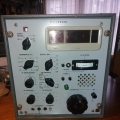The KiwiSDR 2 online store is open for orders! Please visit kiwisdr.nz
Please visit kiwisdr.com (documentation) and kiwisdr.nz (online store)
S meter
Hallo All.
I regularly get asked by listeners in the area who listen to the Kiwi SDR why there is no analog needle S meter. For us here in Holland with many radio pirates, it would be nice if this meter were added. Kind regards, Jos


Comments
Hi Jos,
I think it's mainly down to the additional amount of space it would take up in the control panel.
Personally, I don't understand folk's obsession with S-Meters. There is also the issue of to what standard they are calibrated (or most usually not calibrated) against, but that's just my opinion, and others may disagree.
The existing S-Meter seems to show everything you are asking for, plus IMHO a much more useful digital readout of dBm, which makes signal level comparisons (say when testing antennas) a lot easier.
There is the S-Meter graph extension, which is very useful of longer term monitoring of signal levels and fading etc.
Plus, the spectrum display has a maximum level indicator, which is also very handy for observing peak signal strengths over time.
Just my viewpoint...
Regards,
Martin
Hallo Martin ,
Thank you Martin for your response, everyone has their own ideas about the Kiwisdr.
while on the subject of S-meters.....
back in the 50's S9=100uV EMF or 50uV 50 ohm system..... IIRC
An S-unit was 6 dB
Most radios had terrible S-meter calibration and basically were best for peak indication or relative comparisons.
In this millenium, newer radios have better calibration to a degree, but I note that Yaesu and Icom seem have moved to 3 dB per S-unit.
So depending on an S-meter can often be pretty iffy...
I thought the "gold standard" (at least on HF) was S9 = 50μV (-73dBm @ 50-ohms) and an "S-unit" was 6dB.
In the context of the Kiwi, it's unlikely the antenna is going to be a nice 50+j0 on every frequency from 0-30MHz (unless it's a dummy load!) so the meaningfulness of the "S reading" is somewhat diminished.
Of course this is all with an unmodulated carrier. What to do with a modulated signal that has bandwidth? John can comment as to how the kiwi integrates the selected bandwidth to determine the average or "overall" signal strength. This of course further diminishes the utility of the S-meter as an absolute measurement.
That having been said, there may be some value in using relative S-readings, for example when testing out different antennas...
Regardless, you're 5-9, good luck in the contest!
Nick